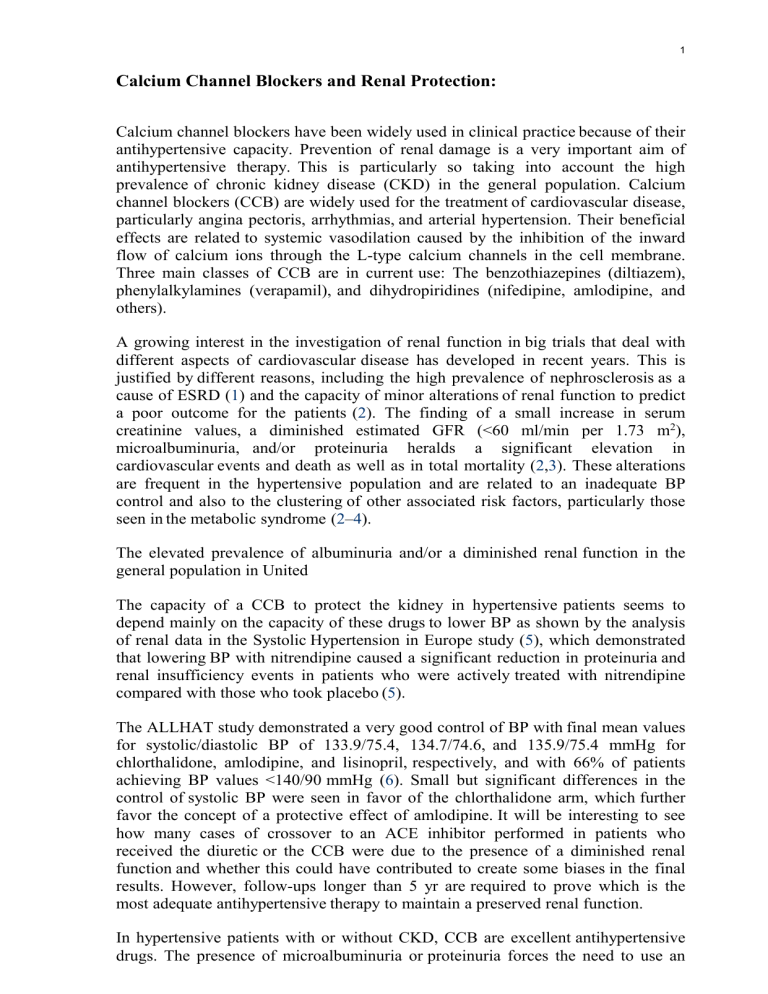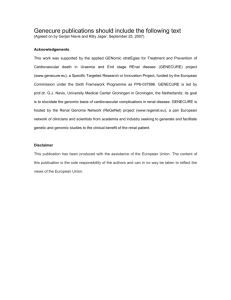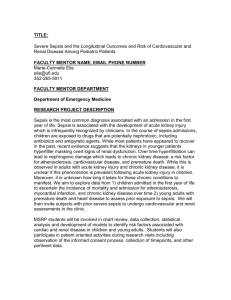Calcium Channel Blockers and Renal Protection (DOC File)

1
Calcium Channel Blockers and Renal Protection:
Calcium channel blockers have been widely used in clinical practice because of their antihypertensive capacity. Prevention of renal damage is a very important aim of antihypertensive therapy.
prevalence
This is particularly so taking into account the high of chronic kidney disease (CKD) in the general population. Calcium channel blockers (CCB) are widely used for the treatment of cardiovascular disease, particularly angina pectoris, arrhythmias, and arterial hypertension. Their beneficial effects are related to systemic vasodilation caused by the inhibition of the inward flow of calcium ions through the L-type calcium channels in the cell membrane.
Three main classes of CCB are in current use: The benzothiazepines (diltiazem), phenylalkylamines (verapamil), and dihydropiridines (nifedipine, amlodipine, and others).
A growing interest in the investigation of renal function in big trials that deal with different aspects of cardiovascular disease has developed in recent years. This is justified by different reasons, including the high prevalence of nephrosclerosis as a cause of ESRD ( 1 ) and the capacity of minor alterations of renal function to predict a poor outcome for the patients creatinine values,
( 2 ). The finding of a small increase in serum a diminished estimated GFR (<60 ml/min per 1.73 m 2 ), microalbuminuria, and/or proteinuria heralds a significant elevation in cardiovascular events and death as well as in total mortality ( 2 , 3 ). These alterations are frequent in the hypertensive population and are related to an inadequate BP control and also to the clustering of other associated risk factors, particularly those seen in the metabolic syndrome ( 2
–
4 ).
The elevated prevalence of albuminuria and/or a diminished renal function in the general population in United
The capacity of a CCB to protect the kidney in hypertensive patients seems to depend mainly on the capacity of these drugs to lower BP as shown by the analysis of renal data in the Systolic Hypertension in Europe study ( 5 ), which demonstrated that lowering BP with nitrendipine caused a significant reduction in proteinuria and renal insufficiency events in patients who were actively treated with nitrendipine compared with those who took placebo ( 5 ).
The ALLHAT study demonstrated a very good control of BP with final mean values for systolic/diastolic BP of 133.9/75.4, 134.7/74.6, chlorthalidone, amlodipine, and lisinopril, and 135.9/75.4 mmHg for respectively, and with 66% of patients achieving BP values <140/90 mmHg ( 6 ). Small but significant differences in the control of systolic BP were seen in favor of the chlorthalidone arm, which further favor the concept of a protective effect of amlodipine.
It will be interesting to see how many cases of crossover to an ACE inhibitor performed in patients who received the diuretic or the CCB were due to the presence of a diminished renal function and whether this could have contributed to create some biases in the final results. However, follow-ups longer than 5 yr are required to prove which is the most adequate antihypertensive therapy to maintain a preserved renal function.
In hypertensive patients with or without CKD, CCB are excellent antihypertensive drugs. The presence of microalbuminuria or proteinuria forces the need to use an
ACE inhibitor or an ARB but does not impede the consideration of a CCB as a part of the combination of agents that will be required by most, if not all, patients. In the absence of albuminuria and with a preserved GFR (>60 ml/min), a CCB can be contemplated as first-step therapy and seems to preserve GFR in an adequate manner. In the presence of a diminished GFR without albuminuria, a CCB can be used as first-step therapy. However, a high percentage combination therapy, and the addition of patients will require of an ACE inhibitor or an ARB will be adequate.
2
Referrence
1.
National Institute of Diabetes and Digestive and Kidney Diseases: US Renal
Data System: Annual Data Report.
Bethesda, MD, National Institutes of Health,
National Institutes of Diabetes and Digestive and Kidney Disease, 1989
2.
Ruilope LM, van Veldhuisen DJ, Ritz E, Luscher TF: Renal function: The
Cinderella of cardiovascular risk profile. J Am Coll Cardiol 38 : 1782 –1787,
2001
3.
Sarnak MJ, Levey AS, Schoolwerth AC, Coresh J, Culleton B, Hamm LL,
McCullough PA, Kasiske BL, Kelepouris E, Klag MJ, Parfrey P, Pfeffer M, Raij
L, Spinosa DJ, Wilson PW; American Heart Association Councils on Kidney in
Cardiovascular Disease, High Blood Pressure Research, Clinical Cardiology, and
Epidemiology and Prevention: Kidney disease as a risk factor for development of cardiovascular disease: A statement from the American Heart Association
Councils on Kidney in Cardiovascular Disease, High Blood Pressure Research,
Clinical Cardiology, and Epidemiology and Prevention. Circulation 108 : 2154 –
2169, 2003
4.
Chen J, Muntner P, Hamm LL, Jones DW, Batuman V, Fonseca V, Whelton PK,
He J: The metabolic syndrome and chronic kidney disease in US adults. Ann
Intern Med 140 : 167 –174, 2004
5.
Voyaki SM, Staessen JA, Thijs L, Wang JG, Efstratopoulos AD, Birkenhager
WH, de Leeuw PW, Leonetti G, Nachev C, Rodicio JL, Tuomilehto J, Fagard R;
Systolic Hypertension in Europe (Syst-Eur) Trial Investigators: Follow-up of renal function in treated and untreated older patients with isolated systolic hypertension. Systolic Hypertension in Europe (Syst-Eur) Trial Investigators. J
Hypertens 19 : 511 –519, 2001
6.
The ALLHAT Officers and Coordinators for the ALLHAT Collaborative
Research Group: Major outcomes in high-risk hypertensive patients randomized to angiotensin-converting enzyme inhibitor or calcium channel blocker versus diuretic. The Antihypertensive and Lipid-Lowering Treatment to Prevent Heart
Attack Trial (ALLHAT). JAMA 288 : 2981 –2997, 2002
3






